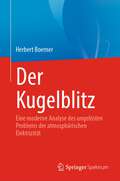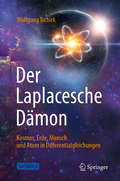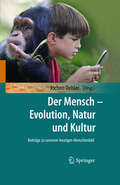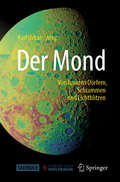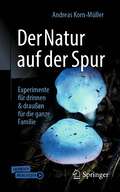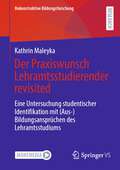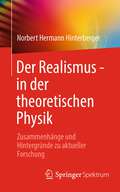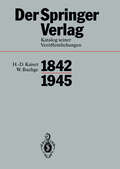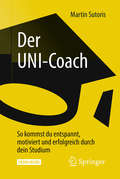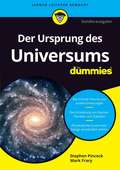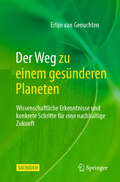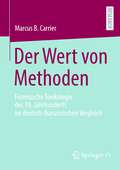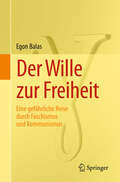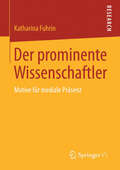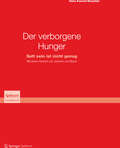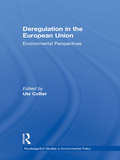- Table View
- List View
Der Klimaschutzdiskurs der „Neuen Rechten“: Eine ideengeschichtliche Analyse des Periodikums Die Kehre – Zeitschrift für Naturschutz (BestMasters)
by Wiebke ZimmermannUmwelt- wie auch konkret der Klimaschutz als dessen jüngerer Teilbereich sind weder neutrale Sachthemen noch notwendigerweise politisch links zu verorten. Im historischen Rückblick lassen sich Momente der geglückten wie gescheiterten Verquickung nationalistischer und antidemokratischer Positionen mit „grünen“ Forderungen im gesellschaftspolitischen Diskurs ausmachen. Auch im Lichte des gegenwärtigen Relevanzgewinns der Causa Klimawandel regen sich im neurechten Lager erneut die Versuche einer (Rück-)Eroberung der Diskurshoheit. Paradigmatisch hierfür steht das neurechte Periodikum Die Kehre – Zeitschrift für Naturschutz, das sich als Debattenort zur Etablierung einer „konservativen Ökologie“, der Verbindung von Ökologie mit rechtsideologischen Elementen, ins Werk setzt. Welche Positionen beziehen, welche Begründungzusammenhänge formulieren Akteur*innen der „Neuen Rechten“ zum Klimaschutz? Die vorliegende Arbeit rekonstruiert Amalgamierungsmomente neurechter (Vorläufer-)Gruppierungen mit Themen des Umweltschutzes und systematisiert so die Chronologie der Genese der „Neuen Rechten“ in einem umweltethischen Zusammenhang. Auf diesem Fundament wird eine Tiefenanalyse der klimaschutzpolitischen Argumentationen innerhalb des neurechten Periodikums Die Kehre geleistet, die identifizierten Positionen werden hinsichtlich ihrer inhaltlichen und strukturellen Brücken in neurechte Traditions- und Ideologiebestände kontextualisiert und interpretiert.
Der Klimawandel-Diskurs in China
by Sidan WangDieses Buch konzentriert sich auf die Politik, den Diskurs und die Akteure rund um den Klimawandel in China. Dieser Rahmen bietet eine neue Möglichkeit, die chinesischen Diskurse zum Klimawandel zu beobachten. Diskursive Veränderungen des Kohleverbrauchs und der Luftverschmutzung werden thematisiert, um die verschiedenen Motivationen Chinas für den Umgang mit Klimafragen aufzudecken. Dieses Buch ist für eine Vielzahl von Akteuren von Interesse, darunter politische Entscheidungsträger, nichtstaatliche Akteure, Wirtschaftskreise und Medien, sowie für alle, die sich für die Klimapolitik Chinas interessieren.
Der Kugelblitz: Eine moderne Analyse des ungelösten Problems der atmosphärischen Elektrizität
by Herbert BoernerKugelblitze sind rätselhaft. Diese leuchtenden Objekte, die gelegentlich während eines Gewitters auftreten und einen Durchmesser von mehreren Metern erreichen können, stellen die Wissenschaft seit etwa 200 Jahren vor Probleme. Trotz mehrerer Tausend gemeldeter Beobachtungen ist ihre physikalische Natur noch immer unbekannt. In diesem Buch werden gut dokumentierte Fälle von Kugelblitzen beschrieben und genutzt, um wichtige Aspekte dieser mysteriösen Form der atmosphärischen Elektrizität zu analysieren. Im Laufe des Buches erörtert der Autor die verschiedenen Facetten des Problems in einem zugänglichen, wissenschaftlich fundierten Text und liefert so einen lesbaren und informativen Bericht, der den neugierigen Leser fesseln wird. Die Analyse kulminiert in der überraschenden Schlussfolgerung, dass die Lösung dieses Rätsels vielleicht schon seit vielen Jahren vorliegt aber bisher nicht erkannt wurde.Ein Vorwort von Earle Williams, dem führenden Blitzforscher am MIT, leitet das Buch ein.
Der Laplacesche Dämon: Kosmos, Erde, Mensch und Atom in Differentialgleichungen
by Wolfgang TschirkDieses Buch nimmt Sie mit auf eine spannende Reise durch die Welt der Wissenschaft: von den Fallgesetzen des Galilei bis zu Einsteins Gravitationswellen, von Newtons Axiomen bis zum Wasserstoffatom, von der natürlichen Auslese bis zum Schwarmverhalten, von der Skala der Empfindungen bis zu den Grenzen des Wachstums auf unserem Planeten. Sie lernen Differentialgleichungen als mächtiges Instrument kennen, das die Mathematik zur Erforschung der Natur bereitstellt. Ihre Lösungen enthüllen, um mit Laplace zu sprechen, die Bewegungen der größten Weltkörper und des kleinsten Atoms und vieles von dem, was dazwischen liegt – einschließlich unserer selbst. Lassen Sie sich von Wolfgang Tschirk begeistern: Er gewährt Ihnen einen unterhaltsamen Blick auf die Verstandesleistungen jener, die dem Laplaceschen Dämon Stück für Stück sein Geheimnis ablauschen. Um Macht und Schönheit der Differentialgleichungen zu erleben, sollten Sie Affinität zur Mathematik mitbringen und auch vor Formeln nicht zurückschrecken. Aber Sie werden sehen: Entgegen ihrem Ruf sind Differentialgleichungen im Grunde leicht zu verstehen und oft sogar leicht zu lösen.
Der Mars: Unsere neue Heimat? (essentials)
by Claus Grupen Marcus NiechciolDie Autoren Claus Grupen und Marcus Niechciol geben in diesem essential einen Ausblick auf die Chancen, der durch Überbevölkerung und Klimaveränderung belasteten Erde zu entkommen. Der Mars als nächstliegender Planet ist ein natürlicher Kandidat für eine Besiedelung durch den Menschen. Aber der Mars ist öd und leer, ohne rechte Luft zum Atmen. Dazu kommt eine ungemütlich hohe Strahlenbelastung. All das führt zu großen Herausforderungen für zukünftige Marsbewohner. Oder ist der Mars doch kein so gutes Ziel?
Der Mensch - Evolution, Natur und Kultur
by Jochen OehlerGut 150 Jahren sind vergangen, seit Darwin sein Werk "Die Entstehung der Arten" geschrieben hat. Das Evolutionsparadigma hat inzwischen als erfolgreicher Forschungsansatz dazu beigetragen, u. a. psychologische, soziale, ethische, ästhetische oder auch politische Fragen zu klären. Namhafte Natur- und Geisteswissenschaftler zeigen in dem Band die Möglichkeiten evolutionärer Erklärungen und Vorhersagen auf. Durch die interdisziplinäre Herangehensweise ergibt sich ein ganzheitliches Bild der Herkunft und der Daseinsweise des Menschen aus heutiger Sicht.
Der Mond: Von lunaren Dörfern, Schrammen und Lichtblitzen
by Karl UrbanKommen Sie mit diesem Buch dem Erdtrabanten näher: Wie sehen wir den Mond heute? Was wissen wir über Entstehung und Aufbau? Hat der Mond einen flüssigen Kern? Was bleibt vom Apollo-Programm und warum läuft aktuell ein neues Rennen zum Mond?In diesem Buch haben wir eine Reihe von allgemeinverständlichen Artikeln zusammengestellt, die unter anderem in Sterne und Weltraum, Wissenschaft im Brennpunkt (DLF) und der Neuen Zürcher Zeitung veröffentlicht wurden und sich mit unserem kosmischen Begleiter auf vielfältige Weise beschäftigen:Was ist das Supermond-Phänomen?Was verraten uns Mondsteine?Wer baut das erste Dorf auf dem Mond?Was haben der Erdmond und der Asteroid Vesta gemeinsam?Was ist die Zukunft der astronautischen Raumfahrt?
Der Natur auf der Spur: Experimente für drinnen & draußen für die ganze Familie
by Andreas Korn-MüllerIn diesem Buch erfahren Sie und Ihre Kinder mit einfachen Experimenten die erstaunliche Wunderwelt der Natur. Was steckt hinter dem Lotus-Effekt? Mit Kohlrabi-Blättern kriegen Sie es raus. Fleischfressende Pflanzen mit Gummibärchen füttern? Geht! Aber warum? Bestimmen Sie die Luftgüte Ihrer Umgebung, eines Parks oder Waldes mit dem selbst gebastelten Flechtenraster. Schnell werden Sie zum Experten der wunderbaren und nützlichen Flechten. Unsichtbare Mikroorganismen eines Sees werden mit einem Laserpointer als tierisches Gewimmel sichtbar – ganz ohne Mikroskop! Die „dunkle“ Seite der Natur entdecken Sie mit einer einfachen UV-Taschenlampe und lassen Gemüse, Pflanzen, Moose, Pilze, Algen, Krebse und Muscheln in bunten Farben leuchten. Eine rot leuchtende Grusel-Paprika zu Halloween? Ja! Eine erforschende Nachtwanderung am Strand? Hurra! Großer Experimentier-Spaß für Drinnen und Draußen für die ganze Familie. Das Buch ist der ideale Begleiter auf Wanderungen und Urlaubsreisen – damit kommen Sie der Natur ein Stückchen näher. Mit zahlreichen Farbfotos, vielen anschaulichen Grafiken und 14 spektakulären Videos. Also: Ab in die Natur!
Der Praxiswunsch Lehramtsstudierender revisited: Eine Untersuchung studentischer Identifikation mit (Aus-)Bildungsansprüchen des Lehramtsstudiums (Rekonstruktive Bildungsforschung #45)
by Kathrin MaleykaDie Dissertation widmet sich dem Ruf Lehramtsstudierender nach „mehr Praxis“ in ihren Studiengängen. Auf der Grundlage fallrekonstruktiver Interviewanalysen wird gezeigt, dass dieser Wunsch als sozialisatorisches Problem verstanden werden kann, resultierend aus dem Zusammenwirken individueller Hochschulsozialisationsprozesse und Strukturen der Lehrkräftebildung. Damit trägt die Untersuchung nicht nur zu einem besseren Verständnis über Ursachen hinter dem Praxiswunsch Lehramtsstudierender bei, sondern verdeutlicht zugleich, dass dieser Wunsch Ausdruck eines komplexen Problems ist, welches die Universität selbst beeinflusst.
Der Realismus - in der theoretischen Physik: Zusammenhänge und Hintergründe zu aktueller Forschung
by Norbert Hermann HinterbergerDieses Fachbuch verteidigt einen kritischen Realismus und diskutiert im Rahmen des de Broglie-Bohm-Ansatzes neuere Arbeiten zum modernen Realismus von Smolin, Dürr, Goldstein, Tumulka, Zanghi und anderen.
Der Springer-Verlag
by W. Buchge H. D. Kaiser Heinz SarkowskiEin Katalog der sämtlichen Veröffentlichungen eines Verlags ist die Leistungsbilanz seiner Arbeit und damit auch ein Ausdruck des Dankes gegenüber dem Gründer und den Verlegergene rationen die ihm nachfolgten. Er ist zugleich die objektivste Dokumentation der Geschichte des Verlags, indem er die Pro duktion seit dem Gründungsjahr nach Einzeltiteln registriert. Der Vorschlag, die Veröffentlichungen des Springer-Verlags seit seiner Gründung möglichst vollständig in einem Katalog nachzuweisen, geht auf das Jahr 1978 zurück. Zunächst stieß der Gedanke auf Skepsis, denn Julius Springer hatte in den ersten Jahren seiner Tätigkeit zahlreiche Broschüren veröffentlicht, die nur für den Tag bestimmt waren. Viele von ihnen fehlen schon in den ältesten der erhaltenen Verlagskataloge aus den 1880er Jahren. Manche wurden nicht einmal in den Leipziger Meßkatalogen angezeigt. In Einzelfällen mag dies auch poli tische Vorsicht geboten haben. Erste Recherchen ergaben dann, daß auch für die Zeit des Vormärz eine weitgehende Vollständigkeit zu erreichen war. Julius Springer hatte sich nämlich keineswegs gescheut, seine politischen Schriften im Börsenblatt anzuzeigen. Bei weiteren Nachforschungen konnten dann auch die meisten dieser Schrif ten in Bibliographien der Zeit ermittelt und gelegentlich auch über den Leihverkehr beschafft werden.
Der UNI-Coach: So kommst du entspannt, motiviert und erfolgreich durch dein Studium
by Martin SutorisVorlesungspläne, Studium in Rekordzeit, Praktikum in den Ferien, am besten noch ein Auslandsaufenthalt … und dann sind da noch der Nebenjob, die Freunde, Hobbys usw. Angesichts dieser Fülle an Herausforderungen ist es nicht leicht, entspannt und motiviert zum erfolgreichen Abschluss zu gelangen. Dieser Ratgeber stellt effektive Entspannungsmethoden, Motivationstechniken und Übungen vor, die einfach in den Studienalltag zu integrieren sind und beispielsweise in folgenden typischen Unisituationen schnell Abhilfe schaffen können:- Prüfungsangst- Nervosität in Referaten- Konzentrationsprobleme- Allgemeine Überforderung- Motivationsdurchhänger Wer diesen UNI-Coach liest, kommt garantiert entspannt und motiviert zum Erfolg!
Der Urknall und andere Katastrophen (Erlebnis Wissenschaft)
by Wiebke SalzmannPhysikalische Kurzgeschichten zur Entstehung unserer Welt - selektiert aus PhiuZ, logisch miteinander verknüpft und leicht verdaulich literarisch aufgearbeitet sind sie unterhaltsame, amüsante und spannende Lektüre für jeden Interessierten.
Der Ursprung des Universums für Dummies (Für Dummies)
by Stephen Pincock Mark FraryEs ist groß, dunkel und im wahrsten Sinne des Wortes maßlos: das Universum. Geht es um das Universum und seinen Ursprung, geraten Naturwissenschaften und Philosophie schnell an ihre Grenzen. Trotzdem oder vielleicht auch gerade deshalb gibt es hier viel Spannendes zu berichten. Wie entstehen Sterne, Planeten und Galaxien, wie wirken die Naturkräfte, was ist dunkle Materie, existiert das Universum ewig? Das sind nur einige der Fragen, auf die Sie in diesem Buch eine verständliche Antwort bekommen.
Der Wandel des Fleischessens im Spiegel medialer Öffentlichkeit: Eine Diskursanalyse über kollektive Wissensbestände von der Nachkriegszeit bis heute
by Verena FingerlingSeit jeher löst Fleisch Kontroversen aus – sei es durch seine ressourcenintensive Gewinnung, die es zum Ausdruck für Wohlstand, Kraft und Gesundheit macht, oder sei es durch moralische Fragestellungen, die sich durch das Nutzen und Töten fühlender Lebewesen ergeben. Anhand des deutschen Leitmediums Der Spiegel setzt sich diese Arbeit mit Wandlungsprozessen öffentlicher Kommunikation über das Fleischessen auseinander. Für den Zeitraum der Jahre 1947 bis 2019 zeichnet sie nach, wie verschiedene Ernährungsdiskurse miteinander verschränkt sind, sich gegenseitig bedingen, befruchten und aufeinander beziehen und zeigt auf, welche Wissens- und Deutungselemente dabei zu verschiedenen Zeiten als relevant oder irrelevant in Erscheinung treten. Methodologisch basiert dies auf Konzepten der Wissenssoziologischen Diskursanalyse nach Keller und der Inhaltsanalyse nach Mayring.
Der Weg zu einem gesünderen Planeten: Wissenschaftliche Erkenntnisse und konkrete Schritte für eine nachhaltige Zukunft
by Erlijn van GenuchtenDieses Buch ist eine Brücke zwischen wissenschaftlichen Erkenntnissen und alltäglichem Handeln für einen gesünderen Planeten. Von der Bewältigung des Klimawandels bis zur Reduzierung von Umweltverschmutzung und dem Schutz der Artenvielfalt bietet dieses Buch leicht verständliche, faszinierende Fakten und praxisnahe Lösungen für jeden, der einen positiven Beitrag für die Umwelt leisten möchte. Basierend auf Erlijn van Genuchten‘s beliebten Artikeln auf medium.com/@ErlijnG werden in diesem Buch zusätzliche Inhalte präsentiert. Alle Kapitel dieses Buches sind auf frei zugänglichen, wissenschaftlichen Veröffentlichungen zu verschiedenen Umweltthemen und Lösungen aufgebaut, die oft nicht in den Medien diskutiert werden. Das Ziel der Autorin ist es, nicht-wissenschaftlichen Zielgruppen diese wichtigen Informationen zugänglich zu machen und das Bewusstsein für drängende Umweltthemen zu schärfen. Durch die Verwendung von leicht verständlicher Sprache und ansprechenden Beispielen aus dem täglichen Leben ermöglicht sie es, das breite Spektrum an Konzepten und Problemen zu erkunden und die weitreichenden Folgen zu verstehen. Darüber hinaus bieten alle Kapitel konkrete Handlungsideen, wie man im täglichen Leben einen positiven Beitrag leistet und die jeder umsetzen kann. Das Buch ist ein multimodales Werk, das nicht nur Text enthält, sondern auch Bilder und Videos, um die Informationen zu veranschaulichen und zu vertiefen. Und um zu ermutigen, aktiv zu werden und die vorgeschlagenen Maßnahmen umzusetzen.
Der Weg zur nachhaltigen Unternehmensführung: Wie Sie Verantwortung für Menschen, Umwelt und Wirtschaft übernehmen (SDG - Forschung, Konzepte, Lösungsansätze zur Nachhaltigkeit)
by Ralf T. KreutzerDieses Buch zeigt, wie Verantwortliche auf allen Unternehmensebenen die Herausforderungen einer nachhaltigen Unternehmensführung souverän meistern können. Hierzu werden konkrete Handlungskonzepte präsentiert.Die Welt ist im Umbruch – politisch, gesellschaftlich und hinsichtlich der natürlichen Ressourcen. Immer mehr Menschen und Institutionen legen ihren Kaufentscheidungen Kriterien zugrunde, die im weiteren Sinne auf Nachhaltigkeit einzahlen. Ralf T. Kreutzer erklärt, wie Unternehmen das Drei-Säulen-Modell der Nachhaltigkeit umsetzen können, um den Anforderungen der Wirtschaft, der Ökologie und des Sozialbereichs (Triple Bottom Line) gerecht zu werden. Gleichzeitig wird aufgezeigt, welche rechtlichen Anforderungen Unternehmen berücksichtigen müssen. Hier sind u. a. das Lieferkettengesetz sowie die Corporate Sustainability Reporting Directive zu nennen. Generell gilt es, die durch die sogenannten ESG-Kriterien (Environment, Social, Governance) beschriebenen Ansprüche seitens der Kunden und weiterer Stakeholder in die Unternehmensführung einfließen zu lassen. Zahlreiche Beispiele aus der Praxis tragen zur Veranschaulichung der Handlungsfelder bei.Der InhaltNachhaltigkeit in der Unternehmensführung und auf KundenseiteInstitutionelle und rechtliche Rahmenbedingungen eines nachhaltigen AgierensIntegration von Nachhaltigkeitskonzepten in die Purpose-Definition von UnternehmenIdentifikation und Ausschöpfung von Nachhaltigkeitspotenzialen in der eigenen WertschöpfungsketteErschließung von Nachhaltigkeitspotenzialen im Marketing und bei der MarkenführungMonitoring und Controlling zur Sicherstellung einer nachhaltigen UnternehmensführungDos & Don‘ts einer nachhaltigen UnternehmensführungEntwicklung einer Green Journey für das eigene Unternehmen
Der Wert von Methoden: Forensische Toxikologie des 19. Jahrhunderts im deutsch-französischen Vergleich
by Marcus B. CarrierGiftmorde zeichnen sich durch die praktische Unsichtbarkeit der Tatwaffe und damit durch eine besondere Heimlichkeit aus. Anders als bei vielen anderen Morden ist so nicht nur die Täterschaft, sondern schon die Tat selbst besonders schwierig festzustellen. Gerichte sind und waren deshalb besonders angewiesen auf wissenschaftliche und medizinische Gutachten. Während des 19. Jahrhunderts entwickelt sich dazu analog zu Entwicklungen in der analytischen Chemie die forensische Toxikologie an der Schnittstelle zwischen Chemie und Gerichtsmedizin. Ihre Aufgabe war es, durch chemische Analysen eine Vergiftung nachzuweisen und die Tatwaffe im wahrsten Sinne des Wortes sichtbar zu machen. In diesem Buch wird analysiert, wie sich die forensische Toxikologie dabei in ihrer Wahl von analytischen Methoden durch die spezifischen gerichtlichen Anforderungen beeinflussen ließ. Dabei werden Entwicklungen der analytischen Chemie genauso in den Blick genommen wie sich verändernde Rechtskontexte in Frankreich und den deutschen Staaten des 19. Jahrhunderts.
Der Wille zur Freiheit
by Manfred Stern Egon BalasDer berühmter Mathematiker Egon Balas nimmt seine Leser mit auf eine erstaunliche Lebensreise: Sie erfahren von großem Mut, grenzenlosem Optimismus und von dem Leid, das Balas auf seinem Weg von Transsilvanien nach Pennsylvania begleitete. Egon Balas wurde 1922 als Sohn ungarisch-jüdischer Eltern geboren, ein Großteil seiner Familie wurde zwischen 1942-1944 ermordet. Nach dem 2. Weltkrieg geriet er in Opposition zum stalinistischen Regime in Rumänien und emigrierte 1966 in die USA. Balas gilt als einer der Pioniere der mathematischen Optimierung.
Der harmonische Oszillator: Eine Reise von der klassischen Physik in die Quantenwelt (BestMasters)
by Niclas WegoDer harmonische Oszillator ist von außerordentlicher Bedeutung für die Beschreibung schwingungsfähiger Systeme in der Natur. Beispielsweise sind die aus der klassischen Physik bekannten Sinus- und Kosinus-Lösungen harmonischer Oszillatoren die Bausteine für die Fourier-Analyse periodischer Funktionen. Andererseits bilden Schwingungsphänomene in der Quantenwelt die Grundlage für unser heutiges Verständnis von Teilchenerzeugung und -vernichtung in der Quantenfeldtheorie. Dieses Buch baut anhand einer gebietsübergreifenden Betrachtung eine Brücke, die den Weg von der klassischen Theorie des harmonischen Oszillators zu dessen quantenmechanischer und quantenfeldtheoretischer Beschreibung eröffnet.
Der junge Carnap in historischem Kontext: 1918–1935 / Young Carnap in an Historical Context: 1918–1935 (Veröffentlichungen des Instituts Wiener Kreis #30)
by Christian Damböck Gereon WoltersThis open access volume is based on the 'Early Carnap in Context’ workshop that took place in Konstanz in 2017 and looks at Rudolf Carnap’s philosophy, documented in his recently released diaries, from a combination of historical, cultural and philosophical perspectives. It enables further evaluation of the diaries and traces newly found interrelationships and their systematic definition. From a cultural and historical point of view, Logical Empiricism and Carnap’s pivotal opus, The Logical Structure of the World, did not evolve in a vacuum. This applies equally in a history of philosophy context as well as under consideration of contemporary historical and cultural influences such as the socio-cultural setting in Vienna and Prague, the correlation between Logical Empiricism and Bauhaus modernism, the connection to the Life Reform Movement or the Youth Movement with its own life philosophy. Pursuing Carnap’s progression on a micro level of history and referring the results back to Carnap’s philosophy is now facilitated by recent access to his Diaries from 1908–1935. These shorthand records, reading lists, travel reports and notes constitute a valuable source for the research of networks and social movements which left their mark on him.
Der prominente Wissenschaftler
by Katharina FuhrinWissenschaftler inszenieren sich in Talkshows, sie veröffentlichen Pamphlete in Publikumsmedien und sind allzeit bereit, wenn Journalisten ein Interview wünschen. Was sind die Motive für diese öffentlichen Auftritte, wenn doch die wissenschaftliche Reputation ausschließlich von der scientific community vergeben wird? Anhand der 21 Interviews mit bekannten Wissenschaftlern wie Hans-Werner Sinn, Harald Lesch, Claus Leggewie, Julia Fischer, Gerd Gigerenzer, Peter Bofinger u. a. zeichnet Katharina Fuhrin ein spannendes Porträt der akademischen Elite Deutschlands und gewährt erkenntnisreiche Einblicke in das Verhältnis von Wissenschaftlern zu Medien und Öffentlichkeit.
Der verborgene Hunger
by Hans Konrad Biesalski Joachim Von BraunIIn Entwicklungsländern ist die Ernährungs-Problematik nicht alleine die unzureichende Versorgung mit Weizen und Reis, sondern die oftmals fehlende Versorgung mit Mikronährstoffen wie Vitaminen und Spurenelementen, die zu massiven Krankheiten (u.a. Blindheit) oder Minderwuchs führen. Selbst bei uns hier in Industrieländern, die wir uns gut ernähren können, treten, was die wenigsten wissen, bei Kindern und v.a. Senioren Mangelerscheinungen auf durch unzureichende Versorgung mit Vitaminen, so beispielsweise bei Vitamin D (geschwächtes Immunsystem; Osteoporose, da Vitamin D die Calcium-Aufnahme fördert). Fotos in Schwarzweiß werten seine Eingangsgeschichten auf.
Deregulation in the European Union: Environmental Perspectives (Routledge/eui Studies In Environmental Policy Ser.)
by Ute CollierExamines the environmental implication of economic deregulation through case studies of the energy, transport and water sectors. The book deals with options for deregulation, looking at self-regulation, negotiated agreements and environmental management systems. Presenting evidence from a number of EU member states and Hungary, a likely contender f
Derek Amato: Accidental Genius (Fountas & Pinnell Classroom, Guided Reading)
by Anderson Mehta Patrick MorganNIMAC-sourced textbook. Mysteries of the Brain. Geniuses—people with almost superhuman mental abilities—are few and far between. Even rarer are people who become geniuses overnight. For Derek Amato, a terrible accident unlocked talents he never had before, and his experience has helped reveal some of the mysteries of the human brain.


